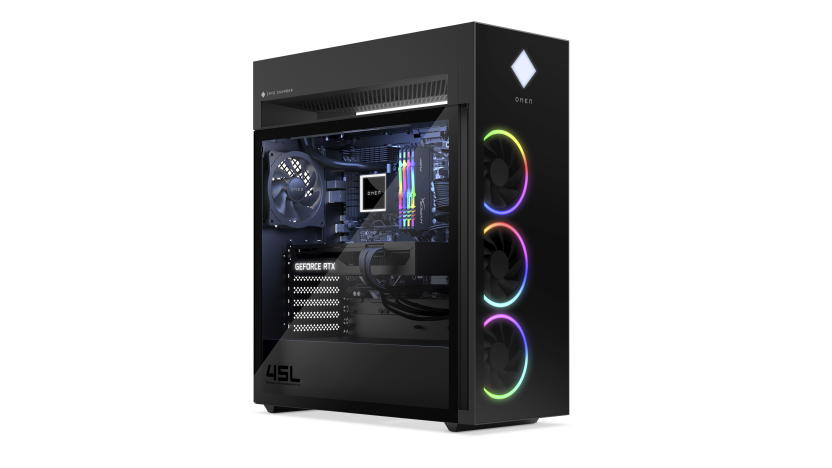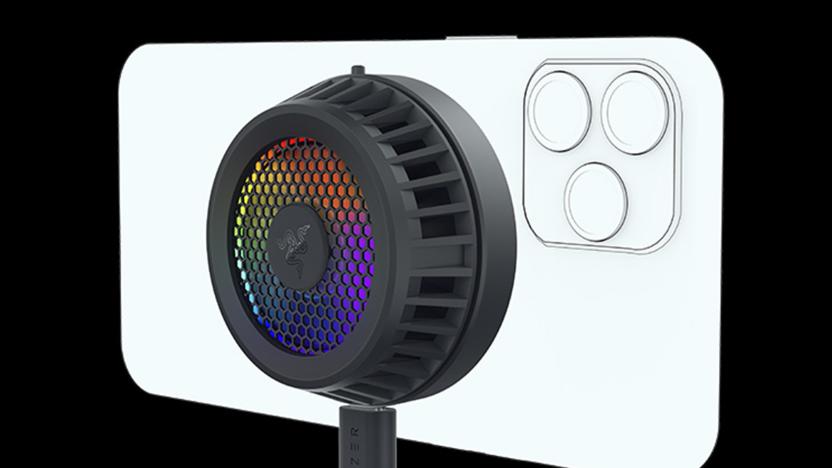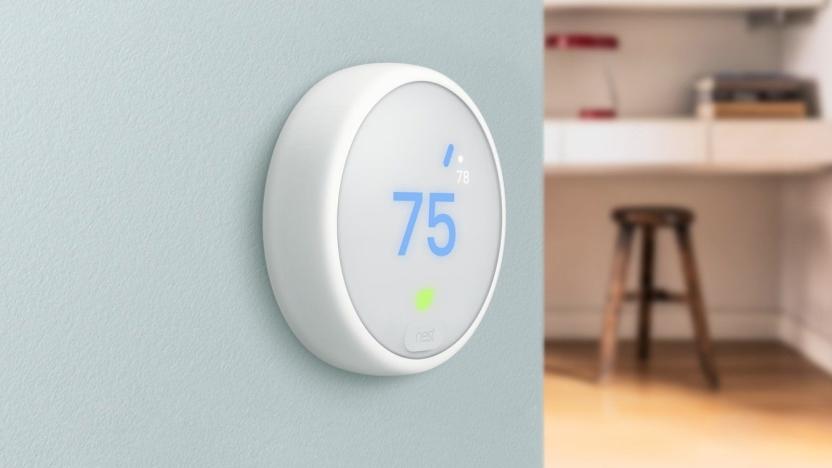cooling
Latest

Google's sustainability features now include an EV buyer's tool
The updates come as part of the company's sustainability wing.

HP's super-sized Omen 45L Desktop has a new kind of cooling system
The company also revealed the first Victus desktop and an Omen gaming monitor with HDMI 2.1 support.

Razer built a MagSafe cooling fan for iPhone gamers
Razer has released a MagSafe cooling fan for your iPhone, complete with RGB lighting.

Sony plans to optimize the PS5's fan speed using game data
Managing heat is a critical part of any video game console. In an interview with 4Gamer.net, Yasuhiro Ootori explained that the console will monitor temperature through a sensor inside the APU and three more attached to the main board. “Various games will be released in the future, and data on the APU’s behavior in each game will be collected,” Otori said (translation provided by ResetEra user orzkare.) “We have a plan to optimize the fan control based on this data.”

Nest makes its Seasonal Savings program free for all thermostat users
The feature makes small tweaks to Nest thermostat settings to help reduce energy consumption. Until now, Seasonal Savings were only available if a customer’s utility provider offered Seasonal Savings programs.

Nest thermostats will warn of possible problems with your AC or furnace
You might not have to wait until your home is frigid to find out that there's a problem with your furnace. Google has started testing a Nest thermostat feature that sends email alerts when the device detects unusual patterns in your HVAC system. If it's taking an oddly long time to warm up your house, you might get a notice well before there's a full-fledged breakdown.

Airbitat's Compact Cooler promises 'deeply cooled' energy-efficient AC
You might not think of your air conditioner (AC) as contributing to climate change, but typical AC units use quite a bit of power, which leads to higher greenhouse gas emissions. In a vicious global warming cycle, as the planet gets hotter, more people will turn to air conditioning. So, companies like Airbitat are working on more efficient cooling methods, like the Airbitat Compact Cooler, which just won a CES 2020 Climate Change Innovator Award.

Google is using AI to run its data center cooling systems
Google's data centers hold thousands of servers and they power everything from Google Search to Gmail to YouTube. But those data centers need to be kept cool in order for those servers to run reliably. A couple of years ago, Google began applying AI to its data center cooling systems and it offered system controllers recommendations about how to boost energy efficiency while maintaining optimal temperatures. Now, Google says its AI is running the show.

Brobot can 'sweat' to do push-ups for longer
The Terminator may not feel remorse or pity, but does it even lift, bro? Researchers from the University of Tokyo have developed a robot called Kengoro that can sweat, helping it get through 11 minute push-up sessions that would normally fry the motors. Unlike a normal water-cooled radiator system, liquid flows into porous aluminum bones and then evaporates on the surface to cool the motors, in the same way that sweat cools a human.

Everything you know is wrong: lasers are cooling things now
A group of scientists at the University of Washington were able to successfully refrigerate water using an infrared laser. This is a big deal because researchers weren't even sure this was possible as water tends to heat up when illuminated. However, by using an infrared laser and nanocrystal, it surprisingly created the opposite effect, which is a world first. The team of scientists were able to cool liquid water by 36 degrees Fahrenheit (20 degrees Celsius). The crystal absorbed the light's photons and then when the photons were released, they had a higher energy value compared to when they first entered. These photons then scattered and carried away heat, cooling the surrounding water.

IBM wants to cool data centers with their own waste heat
Those "do not eat" desiccate packets of silica gel that keep shoe boxes dry could soon help keep data centers cool. IBM has launched the THRIVE project with aims to do just that by creating a heat pump that runs on waste heat.

'3D' white graphene could revolutionize gadget cooling
Graphene seems to be the new millennium's wonder material: it can be used to build more powerful processors, more efficient solar cells, better sounding headphones and, apparently, can even be deep-fried to create long-lasting batteries. Now, researchers at Rice University think that a "3D" variant of the material could change the way we cool our gadgets.

Nest 3.5 update adjusts for humidity and sunlight, fine-tunes fan control
Nest Labs isn't counting solely on the allure of discounts from power companies to reel us in this spring. It's pushing out a 3.5 update to all versions of the Nest Learning Thermostat that should be make it smarter about saving money -- even if it means spending a little up front. Along with the utility tie-ins from last week, the upgrade adds a Cool to Dry mode that invokes air conditioning when it's too humid, raising the energy bill slightly to avoid a costlier mold outbreak. The thermostat also won't be easily duped by the sun: a new Sunblock setting prevents unnecessary cooling whenever direct sunlight affects the temperature reading. Homeowners who just want more precision, meanwhile, may be happy with both refined fan scheduling (shown above) as well as mobile app updates that introduce alert messages and a more thermostat-like interface. Those with Nest units connected to WiFi should see version 3.5, and hopefully its intended savings, by 9PM Eastern tonight.

GE looking to saddle up with TI, bring dual-piezo jet cooling to market
We're often disappointed when 'cool'-looking inventions never come to market, but it looks like the dual-piezo jet fans we saw in GE's labs recently have a fighting chance. The company told us at CES 2013 that it wants to team with Texas Instruments to put the millimeter-thick, bellows-like units inside upcoming Ultrabooks and other devices that have no room for a traditional fan. Such a partnership could work out since GE has little experience in the gadget-space, and TI has all the power conversion bits necessary to make the tech work, since they're similar to the latter outfit's circuits used in so-called high-definition haptics, a tactile feedback system. Representatives from the two outfits said that manufacturers are already working with the tech, meaning we could see the technology in slimmed down products like Ultrabooks within a year -- perhaps just in time to meet Haswell's demanding specs.

GE uses dual piezo jets to keep a Core i7 laptop cool, play a merry tune (hands-on video)
Cooling fans are the bane of many a laptop user's existence. The tiny things are often over-taxed right out of the box and, after a year or two worth of dust and detritus gets in them, they complain more and more loudly. As much as we hate them, engineers hate them more, as they take up precious space beneath the keyboard and draw precious juice from the battery. GE has a better solution, so-called dual piezo cooling jets. They're just 1mm thick, could consume a fraction of the power of a fan and contain no moving parts -- at least, not in the traditional sense. As a demo of their potential, GE created a prototype Core i7-powered laptop, cooled only by these jets. Click on through for our impressions.

Intel treats servers to mineral oil bath in year-long cooling test
If putting liquid cooling pumps, hoses and water inside a highly electrified computer case doesn't seem crazy enough, how about just dunking the whole kit and kaboodle into oil? That's what Intel did with a rack full of servers, and if the oil in question is of the non-conducting mineral kind, it's actually a very chill idea. After a year of testing with Green Revolution Cooling, the chip giant saw some of the best power usage efficiency ratings it's seen, with the oil-cooled PCs easily besting identical, air-cooled units. The company believes more adapted heat sinks could push the gains even further, and affirmed that the technology was safe and didn't affect hardware reliability. Cost savings could be enormous, as server rooms wouldn't need raised floors, air conditioning units or chillers -- if you don't consider oil spills and ruined clothing, of course. [Image credit: Green Revolution]

IBM's water-cooled supercomputer saves energy and helps with your heating bill (video)
IBM's SuperMuc has had a good week. Not only has the three petaflop machine been listed as Europe's fastest supercomputer, but it's also apparently the first high performance computer that's entirely water-cooled. Rather than filling rooms with air conditioning units, water is piped around veins in each component, removing heat 4,000 times more efficiently than air. The hot water is then used to heat the buildings of the Leibniz Supercomputing Centre where it lives, saving the facility $1.25 million per year. After the break we've got a video from Big Blue, unfortunately narrated by someone who's never learned how to pronounce the word "innovative."

Open-mesh PC case keeps heat, dust bunnies at bay
If you haven't done it in a while, opening your PC case can be like a slasher flick -- you know you'll see something disgusting, but you're never sure what. Taiwan's YoungYear Electronics claims to stop the horror with its Green Mesh case, which has neither fans to suck dust, nor filters, and keeps your components cool with a "chimney effect" instead. It's this same action that repels dust out the top, so that only one quarter the usual amount of filth is drawn in -- according to the company. The only downside is that with poor heat dissipation, the maximum power supply unit size is 300 watts -- which probably scratches it off the list for most modders or power-users. For the rest, if you don't mind your computer's innards blowing in the breeze, at least you'd have no nasty case-opening frights.

Intel caught using cheap thermal paste in Ivy Bridge?
For all the good stuff it brings, Ivy Bridge has also been running a little hotter than reviewers and overclockers might have liked -- and that's putting it mildly. A few weeks back, Overclockers discovered a possible culprit: regular thermal paste that sits between the CPU die and the outwardly-visible heatspreader plate. By contrast, Intel splashed out on fluxless solder in this position in its Sandy Bridge processors, which is known have much greater thermal conductivity. Now, Japanese site PC Watch has taken the next logical step, by replacing the stock thermal paste in a Core i7-3770K with a pricier aftermarket alternative to see what would happen. Just like that, stock clock temperatures dropped by 18 percent, while overclocked temperatures (4GHz at 1.2V) fell by 23 percent. Better thermals allowed the chip to sustain higher core voltages and core clock speeds and thereby deliver greater performance. It goes to show, you can't cut corners -- even 22nm ones -- without someone noticing, but then Apple could have told you that.

NC State researcher finds more efficient way to cool devices, looks to cut costs too
Does your electronic device have you a bit hot under the collar these days? A researcher at NC State has developed a faster and less expensive method for cooling gadgets -- especially those that tend to crank the heat up. Dr. Jag Kasichainula, an Associate Professor of Materials Science and Engineering, authored a paper on the research that implements a "heat spreader' composed of a copper-graphene composite and an indium-graphene interface film to cool devices. Because the two materials exhibit a high thermal conductivity, they allow the device to cool more efficiently while distributing said heat -- 25 percent quicker than the pure copper in many pieces of tech. And if that wasn't enough, the research also details the process for creating the composite using electrochemical deposition. "Copper is expensive, so replacing some of the copper with graphene actually lowers the overall cost.," Kasichainula notes. If you're itching to read a full rundown of the findings, the full text can be accessed via the source link below.













